#rotational angular momentum
Explore tagged Tumblr posts
Text

TSRNOSS, p 806.
#rotational angular momentum#velocity of the Earth#zero gravity#bipedalism#anaesthesia#fish under pressure#detoxification#length of sperm#subcutaneous fat#mutational load#balloon#ballast#satyendra sunkavally#theoretical biology#cursive handwriting#manuscript#notebooks
3 notes
·
View notes
Text
Bubbly Tornadoes Aspin

Rotating flows are full of delightful surprises. Here, the folks at the UCLA SpinLab demonstrate the power a little buoyancy has to liven up a flow. (Video and image credit: UCLA SpinLab) Read the full article
#buoyancy#conservation of angular momentum#flow visualization#fluid dynamics#physics#rotating flow#science
62 notes
·
View notes
Text
It is so, so important to me that people understand that Tim didn't figure out the bats because Dick was a "Show off". Like yes, Dick Grayson is the most flamboyant, dramatic ass man you will ever meet.
But the quadruple somersault? There's no way that was because dick was just showing off. Because you're telling me Bruce Wayne, who's so committed to hiding his identity that he literally acts like a completely different person out of the mask in public just to ward suspicion, would miss the fact that Robin regularly uses the flying Grayson's trademark move? There's literally no way.
In the comics we see Tim explain his deductive process to Dick and Alfred and they're both surprised impressed whatever. We don't see him explain it to Bruce. I think Bruce would be surprised and shocked that a 9 year old was able to put the pieces together but I don't think he'd be surprised that the quadruple somersault gave it away.

So if Bruce was possibly aware of such an obvious give away, why let it continue?
I'll tell you why.
It really comes down to the physics
So Dick was 9 when he started out right? That means the most he'd have likely weighed was 43kgs or roughly 95lbs in freedom units.
But Dick and both of his parents are gymnasts who tend to be smaller. So he was likely less than that.
In physics, rotating objects build up angular momentum (this is how bikes stay up right for example). The more rotation, the more momentum. And objects with less mass build up that momentum much faster than those that are heavier.
Robin constantly has to fight people who are nearly 3 times his size. I teach 8 year olds, they're tiny. A quadruple somersault for a small boy that weighs less than a hundred pounds is a brutal weapon. Especially if you add in the acceleration from gravity as he drops in from above.
And I can guarantee you this logic tracks because Dick literally utilizes this idea, without the somersault, in the 2009 teen titans cartoon.
Yeah, that's right. We're talking about the infamous knee drop.
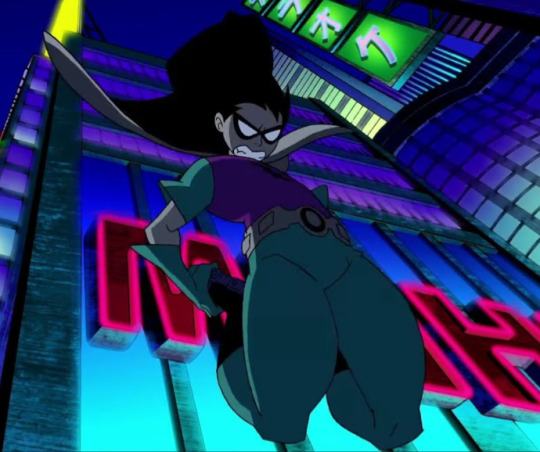
Like it is borderline savage. Add in a quadruple somersault and the resulting force is nearly fatal. It's likely the main reason Batman would ever allow him to do it with the cape on.
Also, Dick landing feet first on the penguin in the first image probably gave the guy severe back issues
#I'm so tired of people giving Dick shit for being a show off#like he is for sure#but thats not what gave him away#it's strategic and practical#he's using the skills he already had in his repertoire to his advantage#also unrelated but#when Tim shows up to convince dick to be robin again#and has to explain how he figured it out#it was just after the arc where dick and bruce had to deal with tony zucco getting out of prison and nearly starting a gang war#pretty sure zucco dies sometime during it#but it brings up a lot of feelings for dick#which is the entire reason Tim finds him at Haley's circus in new york#then Tim immediately reminds him about his parents death again#and technically jasons too because thats his entire purpose for being there#point is#dick was going THROUGH it when Tim shows up#idk thought it bore mentioning#lena speaks#batman#tim drake#dc comics#robin#batman and robin#dick grayson#bruce wayne#nightwing#dc robin#dc analysis#a lonely place of dying#physics
1K notes
·
View notes
Text

Navigating Deep Space by Starlight
On August 6, 1967, astrophysicist Jocelyn Bell Burnell noticed a blip in her radio telescope data. And then another. Eventually, Bell Burnell figured out that these blips, or pulses, were not from people or machines.

The blips were constant. There was something in space that was pulsing in a regular pattern, and Bell Burnell figured out that it was a pulsar: a rapidly spinning neutron star emitting beams of light. Neutron stars are superdense objects created when a massive star dies. Not only are they dense, but neutron stars can also spin really fast! Every star we observe spins, and due to a property called angular momentum, as a collapsing star gets smaller and denser, it spins faster. It’s like how ice skaters spin faster as they bring their arms closer to their bodies and make the space that they take up smaller.

The pulses of light coming from these whirling stars are like the beacons spinning at the tops of lighthouses that help sailors safely approach the shore. As the pulsar spins, beams of radio waves (and other types of light) are swept out into the universe with each turn. The light appears and disappears from our view each time the star rotates.

After decades of studying pulsars, astronomers wondered—could they serve as cosmic beacons to help future space explorers navigate the universe? To see if it could work, scientists needed to do some testing!
First, it was important to gather more data. NASA’s NICER, or Neutron star Interior Composition Explorer, is a telescope that was installed aboard the International Space Station in 2017. Its goal is to find out things about neutron stars like their sizes and densities, using an array of 56 special X-ray concentrators and sensitive detectors to capture and measure pulsars’ light.
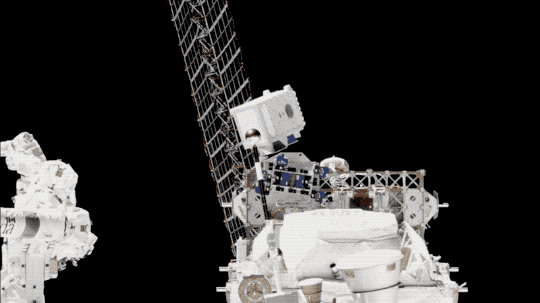
But how can we use these X-ray pulses as navigational tools? Enter SEXTANT, or Station Explorer for X-ray Timing and Navigation Technology. If NICER was your phone, SEXTANT would be like an app on it.
During the first few years of NICER’s observations, SEXTANT created an on-board navigation system using NICER’s pulsar data. It worked by measuring the consistent timing between each pulsar’s pulses to map a set of cosmic beacons.
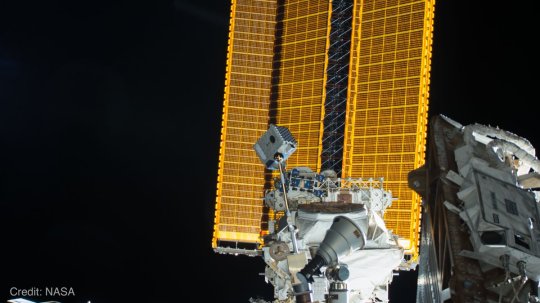
When calculating position or location, extremely accurate timekeeping is essential. We usually rely on atomic clocks, which use the predictable fluctuations of atoms to tick away the seconds. These atomic clocks can be located on the ground or in space, like the ones on GPS satellites. However, our GPS system only works on or close to Earth, and onboard atomic clocks can be expensive and heavy. Using pulsar observations instead could give us free and reliable “clocks” for navigation. During its experiment, SEXTANT was able to successfully determine the space station’s orbital position!

We can calculate distances using the time taken for a signal to travel between two objects to determine a spacecraft’s approximate location relative to those objects. However, we would need to observe more pulsars to pinpoint a more exact location of a spacecraft. As SEXTANT gathered signals from multiple pulsars, it could more accurately derive its position in space.
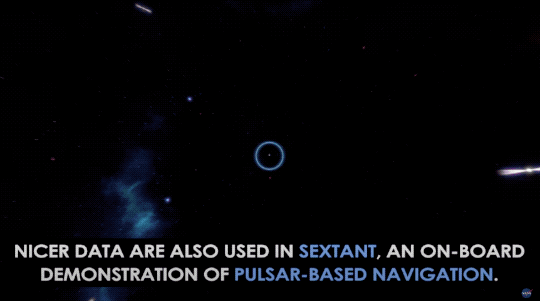
So, imagine you are an astronaut on a lengthy journey to the outer solar system. You could use the technology developed by SEXTANT to help plot your course. Since pulsars are reliable and consistent in their spins, you wouldn’t need Wi-Fi or cell service to figure out where you were in relation to your destination. The pulsar-based navigation data could even help you figure out your ETA!

None of these missions or experiments would be possible without Jocelyn Bell Burnell’s keen eye for an odd spot in her radio data decades ago, which set the stage for the idea to use spinning neutron stars as a celestial GPS. Her contribution to the field of astrophysics laid the groundwork for research benefitting the people of the future, who yearn to sail amongst the stars.
Keep up with the latest NICER news by following NASA Universe on X and Facebook and check out the mission’s website. For more on space navigation, follow @NASASCaN on X or visit NASA’s Space Communications and Navigation website.
Make sure to follow us on Tumblr for your regular dose of space!
#NASA#pulsar#Jocelyn Bell Burnell#spaceblr#space#star#neutron star#deep space#telescope#navigation#universe#astronomy#science
4K notes
·
View notes
Note
Having a Laios moment but thinking about the implications of Izutsumi. Do you think she could squeeze into impossibly smaller cracks? Like how cats can? And I wonder what her flexibility is compared to other tall men. lol I’m just imagining her forcing her way through the underside of a door
From how she moves I think she has above average flexibility for a tallman, I think possibly she works like a cat (if the head passes the rest of the body can too)
Speaking of cats the way they flip in the air is really interesting!
"The photos revealed that the cats turn over by twisting around the middle and rotating the front and back halves separately. By controlling the amount each part turns, they’re able achieve a net rotation while still keeping their total angular momentum constant."

Is this what Izutsumi is doing here? Her front does rotate first and is followed by her legs <3 (thought she wasn't upside down she fixes her position midair very well)
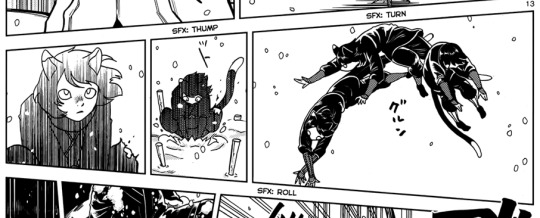
also look at this gif from wikipedia
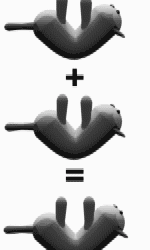
414 notes
·
View notes
Text
𝐂𝐨𝐧𝐭𝐞𝐧𝐭 𝐖𝐚𝐫𝐧𝐢𝐧𝐠𝐬 | Oral (female receiving) and a really bad joke.
𝐌𝐢𝐧𝐨𝐫𝐬, 𝐃𝐨 𝐍𝐨𝐭 𝐈𝐧𝐭𝐞𝐫𝐚𝐜𝐭.

It had been an hour of nonstop, "Eds... Ed... Eddie... Edward?"
But no variation of his name could pull his concentrated eyes from his beloved journal, tormented with the indenting stabs of a pencil, as the gears in his brain were proffering idea after idea for Friday's upcoming campaign.
Hunched, and creating a divot at the end of his bed where his body weight dug into, a whirlwind of wicked sorcery, turned dark wizards, eventually leading to battling evil cultists had captivated his attention, sparing him from the fact that a girl laid naked his bed.
In his defense, his freckled back had been turned to you, where you sat perched by his pillows, homework in hand. But when angular momentum and torque became boring and sprinkled moles on his skin suddenly became enticing, your teeth sunk into your puckered lip at the moistening realization that Eddie Munson had a strong back.
Large expanse, kissable skin, moving muscles toning at any flexion of his upper body; just oh so utterly, hypnotizingly, leg clenching worthy. So can you really be blamed when the bright idea of being rid of your clothes suddenly came about? No, you can't. In fact, a horny finger could always be pointed to the man, himself, for the reason as to why your underwear got sticky when completing Mrs. Wilson's physics homework.
Because it surely wasn't rotational statistics.
As quiet as could be, your thumbs dipped below the waistband of your shorts, hooking onto the elastic cotton of your underwear, where both articles made the journey down your legs, lifting your ass to make the movement smoothly. Your t-shirt quickly followed, nothing of any trouble, letting your breasts fall free as the universe intended.
You could audibly hear the pencil scribbling the chicken scratch that was your boyfriend's handwriting when you sat up to feel your knees shove into his lumpy mattress; probably some fantastical enchantment that you wouldn't understand, but so deeply care about if it meant seeing Eddie's shining face whenever he'd tell you about it.
Hushed movements led you towards him, where the gentle touch of your fingertips upon his broad shoulders elicited a hum of activation from him. But it hadn't been until your grip tightened, pulling his body back, that his attention was pulled away from his notebook, as he was abruptly being met with the surprise of your cunt hovering over his head, as he hit the mattress.
A book and pencil dropped, as no time was wasted when your body sunk onto his welcoming mouth. Eddie's large hands were quick to snake a hold onto the fat of your ass to have you seated on his lips, encouraging your hips to hump what was yours. That lingering fear of potentially crushing him that he hated was no longer being accepted on his terms.
You were sat.
"Mm, just didn't want- ugh," you gasped, as the sharp tip of his tongue parted your slick folds to pour your juiced into his mouth, "didn't want you to get tunnel vision- fuck, Eddie!"
"Uh-huh!" His moans vibrated through your pussy, as his lips latched onto your pulsating clit, only to abuse it with the suctioning shake of his head. Yours fingers clawed at his bare chest, where your palms found the support to gyrate your hips. "Only vision I see is me in your tunnel."
Unbelievable. Airy chuckles escaped your mouth, as your fingers were brisk to pinch his growing bulge through the stretching material of his sweatpants in retaliation. His legs jolted, attempting to squirm away, as he laughed into your pussy, only drawing more moans from you atop, as his boyish cackles only gave way for more tremoring sensations against your oozing cunt.

𝐀𝐮𝐭𝐡𝐨𝐫'𝐬 𝐍𝐨𝐭𝐞 | Short smut while I find the will to write long smut.
#stranger things#eddie munson#eddie munson imagine#eddie munson fanfic#eddie munson fluff#eddie munson smut#eddie munson blurb#eddie munson x fem!reader
632 notes
·
View notes
Text
HOW TO DESTROY A BLACK HOLE??
Blog#460
Saturday, December 7th, 2024
Welcome back,
Black holes want to absorb all matter and energy in the Universe. It’s just a matter of time. So what can we do to fight back? What superweapons have been devised to destroy black holes?
Black holes are the natural enemies of all spacefaring races. With their bottomless capacity to consume all light and matter, it’s just a few septillion years before all things in the Universe have found their way into the cavernous maw of a black hole, crushed into the infinitely dense singularity. If Star Trek has taught us anything, it’s that it’s mankind’s imperative to survive against all odds.

So will we take this lying down?
Heck no!
Will we strike first and destroy the black holes before they destroy us?
Heck yes!
But how? How could you kill a black hole?
This… gets a little tricky.
For a black hole, any matter entering the event horizon is added to the mass. Shoot bullets at a black hole, and you just make a slightly more massive, slightly more dangerous black hole. Detonate a nuclear bomb inside the event horizon, and you only make the black hole more massive.

Fire your forward phasers at the black hole, and that’ll still make it even more massive. Swap those bullets in for lasers and black holes don’t care. Within the event horizon, energy and matter are one, and those very same black holes can convert that energy into mass. So all your projectiles and energy weapons inevitably just make it more dangerous.
What if we crashed a star into it? Would that fill it up, or burn it out? Nope. It would just gobble that star up, and go on with its business. If we smashed another black hole into it? Would that tear it apart? The cause is also the cure? Not even maybe. As soon as black holes get within each other’s event horizons, they’ll just merge into a more massive, and even nastier, meaner black hole.

Number 1, it’s time to bring out the big guns. Reverse the particle flow, flood the dilithium chamber with exotic particles and route it through the main deflector dish, and construct your own black hole out of antimatter. Then kamikaze this new antimatter black hole right into a the black hole you want to destroy. Would that do it? Would that solve our problem?
As you probably know, when you crash matter into antimatter, you get an explosion of pure energy. It’s the most perfect energy weapon we can envision. Unsurprisingly, this brings its own set of complications. It’s not entirely clear you’ve still have antimatter in your antimatter black hole. It’s possibly been converted into a regular flavour black hole.

Still, if you *could* crash an antimatter and regular matter black hole together, you would get an incomprehensible explosion. Converting that entire dense and gigantic mass into pure energy, as calculated by Einstein. As soon as you did, all that energy would be immediately converted… into more black hole.
Nothing, not even light itself can escape a black hole. That includes all your magnificent explosion energy from your antimatter impact. You wouldn’t even see it happen. You’d just end up with a black hole with twice the mass. And that might be just what it wants.

As we learned in a previous episode, we can extract angular momentum from a black hole. By dropping material into the event horizon, we can remove energy and slow its rotation. We can even bring it to a stop. So we can slow down its spin, but that won’t make it go away.
So, is that it, are we out of options? Good news, we have one last strategy, and it’s so crazy it just might work. According to Stephen Hawking, black holes can actually evaporate over enormous periods of time.

Virtual pairs of particles are constantly popping into existence all around us. Then they recombine in a flash and disappear from the Universe. When one of these particle pairs appears right on the edge of a black hole, one particle falls into the black hole, and the other is free to fly off into space. And here’s the amazing thing. This might actually reduce the overall mass of the black hole.
So, over an incomprehensible period of time, even the most supermassive of the black holes will have evaporated away into a harmless soup of particles. It turns out, in order to defeat the black hole menace, all we need to do is ignore them, and they’ll go away all on their own.
Originally published on https://www.universetoday.com
COMING UP!!
(Wednesday, December 11th, 2024)
"HOW ARE BLACK HOLES CREATED, AND HOW DO THEY GROW??"
#astronomy#outer space#alternate universe#astrophysics#universe#spacecraft#white universe#space#parallel universe#astrophotography
69 notes
·
View notes
Note
hello!!! its ballet anon from a while back. been keeping up with ur blog (genuinely my favorite rp blog for arcane congrats mun). as a bit of a mental exercise, would there actually be mathematical equations for different moves in ballet? like in swan lake, where the black swan does 32 fouettes. or the concept of being en pointe (how tf do we balance all of our weight on one toe its insane)
also, you remind me of one of my dance teachers. she was very strict, no-nonsense, had high standards, and lectured us for 20 minutes every week. but she was also probably the kindest teacher i've ever had. she once fired a teacher for being transphobic to me and would always make sure i had money for food
Hello again, my friend.
There absolutely are mathematical and physical principles behind ballet. Fouettés, like the Black Swan’s 32, rely on angular momentum. When you turn, you manipulate your momentum of inertia: extending the leg slows rotation, while pulling it in speeds it up. Balancing on one toe, en pointe, involves maintaining your center of mass directly over the tiny surface area of the pointe box, while your body constantly makes micro-adjustments through muscle torque and proprioception. The force on that one foot can exceed three times your body weight. It is not just skill you display, but engineering through agony!
I applaud your dedication. Your ballet teacher would be proud to know how you carry her strength. You have long lived at the intersection of art, science, and survival.
#arcane viktor#arcane rp#viktor lol#viktor league of legends#askviktor#arcane#viktor#arcane roleplay#viktor arcane#ask viktor#viktor rp arcane#viktor roleplay#viktor rp#viktor arcane roleplay#viktor arcane rp#arcane rp blog#arcane league of legends#arcane lol
21 notes
·
View notes
Text
Noether’s theorem implies any conservation law arises from a symmetry, e.g., angular momentum from rotational symmetry or energy due to time symmetry. Is the conservation of charge in electromagnetism due to gauge symmetry, or some other symmetry? I feel like I saw something like this mentioned somewhere once but Google is being unhelpful as usual.
#something about how if you have a theory with Lorentz invariance and gauge symmetry#it’s always going to end up looking like electromagnetism?#I may be wildly misremembering this
52 notes
·
View notes
Text
The gyroscope and the box demonstrates the principles of conservation of angular momentum and Newton’s Third Law of Motion. The gyroscope, by exerting a torque on the box to maintain its orientation, causes the box to rotate in the opposite direction. This conservation of angular momentum ensures that the total angular momentum of the system (gyroscope + box) remains unchanged.
44 notes
·
View notes
Text

Scientists prove long-standing wave amplification theory
Physicists at the University of Southampton have tested and proven a 50-year-old theory for the first time using electro-magnetic waves. They have shown that the energy of waves can be increased by bouncing "twisted waves"—those with angular momentum—off of an object which is rotating in a specific way. This is known as the "Zel'dovich effect," named after Soviet physicist Yakov Zel'dovich who developed a theory based on this idea in the 1970s. Until now, it was believed to be unobservable with electromagnetic fields. "The Zel'dovich effect works on the principle that waves with angular momentum, that would usually be absorbed by an object, actually become amplified by that object instead, if it is rotating at a fast enough angular velocity. In this case, the object is an aluminum cylinder and it must rotate faster than the frequency of the incoming radiation," explains Research Fellow at the University of Southampton, Dr. Marion Cromb.
Read more.
22 notes
·
View notes
Text
Hypermobility
Okay wait I have a prompt!!! If you wanna So I've been reading a lot of fics recently that are in space aus, with the whole humans are deathworlders concept (idk how this is common across my fandoms but it is so I'm binging them lol). And I had an idea based on recent irl events. – anon (long ask, cut for brevity)
inspired by my lovely @ghostofasecretary who has trained all of our friend group to look for hypermobility on account of our schlorpy joints :)
Read on Ao3
Warnings: none
Pairings: loosely implied analogical i guess, but as with most of my shit can be platonic or romantic you decide
Word Count; 1809
Remus glances up to see Virgil staring at Logan like his abdomen has spontaneously ruptured. He sees Roman out of the corner of his eye do the same. Virgil swallows heavily. "L," he says slowly, "what the fuck is wrong with your arms?" "Nothing is wrong with my arms, what are you talking about?" "Elbows don't bend like that!" Ah. So there was something wrong. Remus was right. Take that, human etiquette manual. Wait, shit, something's wrong with Logan.
Roman clicks at Remus as he comes onto the lab floor. Remus clicks back as he logs onto his station, sighing as he looks at the absolute mess someone's fucking made of the logs—seriously, it's only been one quarter cycle, how are they this fucked up already?—and Roman immediately leans over to see what he's sighing at.
"Wait, what's that?"
"Some xetron made an absolute fucking disaster out of the hadron logs."
Roman winces in sympathy and his carapace shifts. "Are you gonna do yours before you clean that up, or—?"
The last part of his question gest interrupted when Logan comes onto the floor, waving a brief hello with his fingers instead of his antenna—because humans don't have antennae, which was a pretty sharp learning curve for both of them when they'd been so confused as to why this human was refusing to talk to them or even show his feelings, they'd had a few apologetic shifts before Logan realized what was going on and explained everything—and raising an eyebrow when he noticed them clustered around Remus's station.
"Is there something wrong?"
"The shift before us messed up their hadron logs."
Logan rolls his eyes. "You'd think that for life forms insistent that their gravitational curves made them more naturally prepared for graviton scans, they'd have a better sense of how to record them properly."
"You're spellcasting on the acolytes, Logan."
Logan frowns, glancing at his tablet, before the equivalent phrase pings on the screen and he hums. "Ah, I see. Yes, well, if you'd like my help at any point, I only have the routine gamma sweeps to do this shift, so I should be amenable."
"Oh, I can do it, it's just a pain in my thorax."
Roman chuckles and heads back to his own station, probably to sneakily-not-so-sneakily ask some of the others on the shift who are fucking competent what the fuck happened. Remus gets himself ready to dive into the long and tedious work of redoing the spin increments and calculating the proper uncertainties for the right variables—honestly, do they even look at the readouts? It has the layout right there! And it's not like the other logs are invisible! Just look at the rows two microns above the empty one you're supposed to be filling out!—and manages to sink into a rhythm for the first half of the shift. Granted, he's absolutely muttering about how stupid it is that they aren't even calculating the basic momentum, let alone the angular velocity to account for the other celestial bodies in the middle of the waveforms, but it's fine, and Roman keeps up his running commentary of the molecular analysis machine that takes its sweet-ass time to do even the most basic of scans, and every so often he'll hear a small huff from Logan as he corrects their probe's trajectory, but for the most part, the lab is a quiet and serene place to be.
God, he can't wait until he gets rotated back to the engineering department full-time.
Like, yeah, he likes spending time with his brother, and the human's cool—he's really funny when he lets himself be, like his wit is drying than the mountain deserts on Cre-Ativa, and his facial expressions are fucking plat when their superiors are being xetrons, but there's only so much he can take of this quiet where not much happens. And he has to deal with the idiots who don't know how to format hadron logs correctly. This is the third time he's had to correct a typo that's rendered the rest of the calculations useless.
"I'm honestly about to recommend them for a review of the training course, that's how fucking serious this is."
"Maybe there's something wrong with how the keyboard is adapted for their limbs?"
"That would explain some of the typos, not all of them. And it definitely wouldn't explain why there's a massive formatting change about halfway through."
"Perhaps there's a shorthand they're using for some of the notes that we don't know about, and they're forgetting to correct them at the end of their shift."
"Yeah, but then they should tell us that, instead of—" Roman trails off and Remus looks up.
Logan is…stretching, yes, that's the right word. His limbs are extended over his head and his back is arched, but his upper limbs are…bending. Not like the way they normally bend, they're bending…too much? Not enough? The wrong way? Yeah, that's it. The wrong way.
Logan notices they've gone quiet and looks over. "Is there something wrong?"
"You're, uh," Remus stammers, "are you—okay?"
"Yes, I'm perfectly fine, what is it?"
"Nothing, nothing."
He and Roman exchange a look—the first rule in the human etiquette training manual was if they get weird, just roll with it for a reason—and get back to minding their own business. Admittedly, some of the errors do make more sense now that he's looking at it like it's some kind of shorthand he doesn't know yet, but that wouldn't explain why some of these variables are straight-up wrong and why they wouldn't bother to tell him what the shorthand is so that he's not trying to do the work of two shifts in the time of one.
Something he does appreciate is that the way the shifts in the lab are set up, opposed to engineering, is that sometimes there will be people whose shifts halfway overlap with theirs. So there's always at least one set of people that are staying in the lab while a changeover is happening and then there's not that risk that the equipment will be left unattended. Apparently they learned that lesson the hard way when the molecular exhibitor decided to go into overload in the five minutes where there wasn't anyone logged in, and nearly destroyed the matter wave projector on the station next to it. The justification was in the name of safety, but really everyone knows it's just so the higher-ups know exactly who to blame when shit goes awry.
Whatever the case may be, the door slides open to reveal the other human down here, Virgil, yawning as he makes his way over to his station.
"Hello, hello, everyone."
"Hi, Virgil!"
Virgil winces. "You are way too chipper this early in the morning."
"It's past the circadian half cycle, Virgil."
"Yeah, and?"
"I'm afraid you're going to have to acclimate to your schedule on your own time," Logan says, stretching again, "even though I'm sure your caffeine tolerance has—what? Why are you looking at me like that?"
Remus glances up to see Virgil staring at Logan like his abdomen has spontaneously ruptured. He sees Roman out of the corner of his eye do the same. Virgil swallows heavily.
"L," he says slowly, "what the fuck is wrong with your arms?"
"Nothing is wrong with my arms, what are you talking about?"
"Elbows don't bend like that!"
Ah. So there was something wrong. Remus was right. Take that, human etiquette manual.
Wait, shit, something's wrong with Logan.
"Logan? Do we need to take you to medbay?" Roman's already rushing out from behind his station. "There's a pack in the corner, I can—"
"Oh, for—relax, all of you, I'm fine."
"Uh-huh, yeah, fine, that's what I'd describe elbows that bend all schlorpy as, yeah," Virgil says, "what the—does that not hurt?"
"What? No, it doesn't hurt, look, your joints—"
"My joints suck ass but at least they're fucking bending the amount they're supposed to!"
Remus isn't quite sure how human joints are capable of such a surprising and invasive act, but never let it be said he's not curious. "Your joints are capable of performing anal suction?"
"What the fuck? No! It's a turn of phrase!"
"Oh. Disappointing."
"Ignore him," Roman says, "Logan, are you sure you're—"
"Yes, yes, I'm fine, I'm just—oh," he mumbles, prodding at his tablet, "what's the word for this in Common?"
"There's no word for schlorpy elbows, Logan—"
"Yes, there is!" He pokes around for a few more seconds before he lets out a noise of triumph and says something that the translators don't translate.
"It's what?" Virgil just shakes his head when Logan tries again. "I don't know what that means, bud."
Logan sighs, pinching the bridge of his nose. "Okay, let me try it this way. What's it called when you are in a state of heightened energy and it leads to outbursts of things like running around, or talking too loudly, or being high-strung?"
"Remus," Roman offers helpfully.
"No, Roman."
"Are you talking about being excitable?"
"No, there's a specific word for it. It also serves as a prefix for being too much of something, or an overabundance of something."
"Too much—do you mean the word hyper?"
"Yes! Yes, that's it. And then what's the name of the thing that some people hang over cribs that have little stars or animals?"
Virgil stares at Logan for another moment. "You mean a baby mobile?"
"Yes, but only the second word."
"Mobile?"
"Yes, that's it. Then put the two words together—"
"There were probably so many other ways you could've said you were hypermobile, L, I'm just gonna put that out there—"
"Well, it got you to guess it, didn't it?"
"It's too fucking early for this shit."
"Again, it is afternoon—"
"Shut up."
Roman looks back and forth between the two humans, still twitching as though he's going to be asked to sprint for the medbay at a moment's notice. "So…is Logan…are you alright?"
"Yes, for the fourth time, I'm fine. Virgil's just a little excitable, that's all."
"You try being normal when joints are doing unexpected things," Virgil mumbles, more to his caf than anything else, but he reaches behind himself to pat Roman's carapace. "He's fine, his body just does that."
"But you said it bends the wrong way, how is that fine?"
"There is a thing known as hypermobility," Logan says, "it…oh, dear, it basically means that certain joints will bend…more."
"He's not hurt, that's pretty much all I know."
Roman looks like he's about to protest but Remus just clicks at him. They exchange another look as the humans settle back to work.
Humans are weird, just gotta roll with it.
These hadron logs, on the other hand—
"I'm gonna punt these flimflobbers into the next star we see."
"Can I help? They fucked up the carbon dating program as well."
"How do you fuck that up?"
"Ask them, not me!"
General Taglist: @frxgprince@potereregina@gattonero17@iamhereforthegayshit@thefingergunsgirl@awkwardandanxiousfander@creative-lampd-liberties@djpurple3@winterswrandomness@sanders-sides-uncorrect-quotes@iminyourfandom@bullet-tothefeels@full-of-roman-angst-trash @ask-elsalvador @ramdomthingsfrommymind@demoniccheese83@pattonsandershugs @el-does-photography @princeanxious@firefinch-ember@fandomssaremysoul@im-an-anxious-wreck@crazy-multifandomfangirl @punk-academian-witch@enby-ralsei@unicornssunflowersandstuff@wildhorsewolf @thetruthaboutthesun @stubbornness-and-spite @princedarkandstormv @your-local-fookin-deadmeme @angels-and-dreams@averykedavra @a-ghostlight-for-roman @treasurechestininterweb @cricketanne @queerly-fluid-fan @compactdiscdraws@cecil-but-gayer@i-am-overly-complicated@annytheseal@alias290@tranquil-space-ninja @arxticandy @mychemically-imbalanced-romance@whyiask@crows-ace @emilythezeldafan@frida0043 @ieatspinalcords @snowyfires@cyanide-violence@oonagh2@xxpanic-at-the-everywherexx@rabbitsartcorner @percy-07734@triflingassailantofmyemotions @virgil-sanders-the-gay-emo@cerulean-watermelon@puffed-up-bees@meltheromanstan@joyrose-fandomer@insanitori@mavenmush@justablah65@10paradox10@uhhh-hi-there-i-am-nervous@cutebisexualmess@bella-bugatti-frogetti-baguetti@ultrageekygirl
#dragonbabbles#fic#sanders sides#roman sanders#remus sanders#sympathetic remus#logan sanders#virgil sanders#humans are weird#humans are space orcs
69 notes
·
View notes
Text
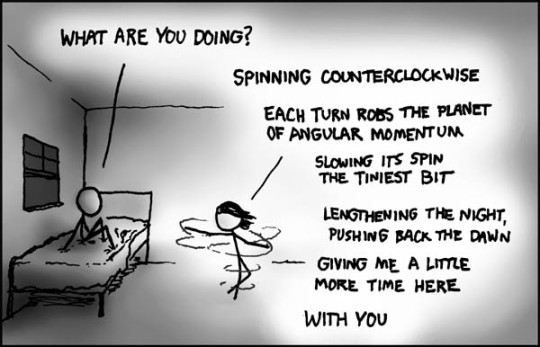
With reasonable assumptions about latitude and body shape, how much time might she gain them? Note: whatever the answer, sunrise always comes too soon. (Also, is it worth it if she throws up?)
Angular Momentum [Explained]
Transcript Under the Cut
[Cueball sits sideways on a bed under an open window in the corner of a room. He is looking at Megan, who is spinning fast, indicated with two large circles indicating where her arms that are spread far out rotate, as well as two smaller circles around her knees and feet. The bed sheets are clearly messed up, as if someone has used it for activities other than sleeping. It is night and dark gray outside the window, and inside the room everything is also gray but lighter. Behind the spoken text, the background is white, but fades to the darker gray at the edges. There is also different gray shading in different parts of the room.] Cueball: What are you doing? Megan: Spinning counterclockwise Megan: Each turn robs the planet of angular momentum Megan: Slowing its spin the tiniest bit Megan: Lengthening the night, pushing back the dawn Megan: Giving me a little more time here Megan: With you
109 notes
·
View notes
Text
It works!*
So I (FINALLY) put the final touches on the software for my robot PROTO! (Listen, I am a software person, not a coming-up-with-names person)
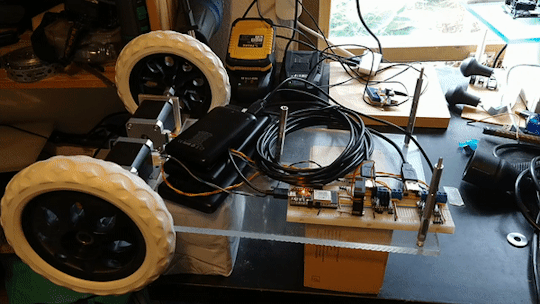
Basically, it is a ESP32 running him. He takes HTTP messages. Either GET odometry, or PUT twist. Both just being a string containing comma separated numbers
Odometry is the robots best guess based on internal sensors where it is (Since PROTO uses stepper motors, which rotates in tiny tiny steps... it is basically counting the steps each motor takes)
Twist is speed, both in x,y and z directions, and speed in angular directions (pitch, roll and yaw). This is used to tell the robot how to move
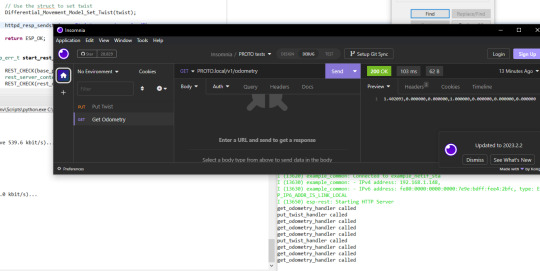
Now, since PROTO is a robot on two wheels, with a third free-running ball ahead of him, he cannot slide to the side, or go straight up in the air. You can TRY telling him to do that, but he will not understand what you mean. Same with angular movement. PROTO can turn left or right, but he have no clue what you mean if you tell him to bend forward, or roll over.
The software is layered (Which I use a BDD diagram to plan. I love diagrams!)

Basically PROTO gets a twist command and hands that over to the Differential_Movement_Model layer.
The Differential_Movement_Model layer translate that to linear momentum (how much to move forward and backwards) and angular momentum (how much to turn left or right). combines them, and orders each wheel to move so and so fast via the Stepper_Motors layer.
The Stepper_Motors turns the wanted speed, into how many steps each stepper motor will have to do per second, and makes sure that the wanted speed can be achieved by the motors. It also makes sure that the wheels turn the right way, no matter how they are mounted (In PROTO's case, if both wheels turn clockwise, the right wheel is going forward, and the left backwards.). It then sends this steps per second request down to the Peripheral_Hub layer.
The Peripheral_Hub layer is just a hub... as the name implies, it calls the needed driver functions to turn off/on pins, have timers count steps and run a PWM (Pulse-width modulation. It sends pulses of a particular size at a specific frequency) signal to the driver boards.
Layering it, also means it is a lot easer to test a layer. Basically, if I want to test, I change 1 variable in the build files and a mock layer is build underneath whatever layer I want to test.
So if I want to test the Stepper_Motors layer, I have a mock Peripheral_Hub layer, so if there are errors in the Peripheral_Hub layer, these do not show up when I am testing the stepper motor layer.
The HTTP server part is basically a standard ESP32 example server, where I have removed all the HTTP call handlers, and made my own 2 instead. Done done.
So since the software works... of course I am immediately having hardware problems. The stepper motors are not NEARLY as strong as they need to be... have to figure something out... maybe they are not getting the power they need... or I need smaller wheels... or I will have to buy a gearbox to make them slower but stronger... in which case I should proberbly also fix the freaking cannot-change-the-micro-stepping problem with the driver boards, since otherwise PROTO will go from a max speed of 0.3 meters per second, to most likely 0.06 meters per second which... is... a bit slow...
But software works! And PROTO can happily move his wheels and pretend he is driving somewhere when on his maintenance stand (Yes. it LOOKS like 2 empty cardboard boxes, but I am telling you it is a maintenance stand... since it sounds a lot better :p )
I have gone over everything really quickly in this post... if someone wants me to cover a part of PROTO, just comment which one, and I will most likely do it (I have lost all sense of which parts of this project is interesting to people who are not doing the project)
129 notes
·
View notes
Text
Guessing your age might be a popular carnival game, but for astronomers it's a real challenge to determine the ages of stars. Once a star like our sun has settled into steady nuclear fusion, or the mature phase of its life, it changes little for billions of years. One exception to that rule is the star's rotation period—how quickly it spins. By measuring the rotation periods of hundreds of thousands of stars, NASA's Nancy Grace Roman Space Telescope promises to bring new understandings of stellar populations in our Milky Way galaxy after it launches by May 2027. Stars are born spinning rapidly. However, stars of our sun's mass or smaller will gradually slow down over billions of years. That slowdown is caused by interactions between a stream of charged particles known as the stellar wind and the star's own magnetic field. The interactions remove angular momentum, causing the star to spin more slowly, much like an ice skater will slow down when they extend their arms.
Continue Reading.
#Science#Space#Astronomy#Physics#Stars#Ai#Artifical Intelligence#NASA#National Aeronautics and Space Administration
47 notes
·
View notes
Text



Forgotten property of the electron
Physical discovery opens up new avenues for “orbitronics”
The orbital angular momentum of electrons has long been considered a minor physical phenomenon, suppressed in most crystals and largely overlooked. Scientists at Forschungszentrum Jülich have now discovered that in certain materials it is not only preserved but can even be actively controlled. This is due to a property of the crystal structure called chirality, which also influences many other processes in nature. The discovery has the potential to lead to a new class of electronic components capable of transmitting information with exceptional robustness and energy efficiency.
From electronics to spintronics, and now to orbitronics: In classical electronics, it is primarily the charge of the electron that counts. In modern approaches such as quantum computing and spintronics, the focus has shifted to the electron’s spin. Now, another property is entering the spotlight: orbital angular momentum (OAM). In simple terms, OAM describes how the electron moves within an atom – not in a classical orbit, but as a quantum mechanical distribution within an orbital.
“For decades, spin was considered the key parameter for new quantum-based technologies. But orbital angular momentum also has great potential as an information carrier – and is significantly more robust,” explains Dr. Christian Tusche from the Peter Grünberg Institute (PGI-6) at Forschungszentrum Jülich. The physicist is one of the lead authors of the study published in the renowned journal Advanced Materials.
The orbital angular momentum is one of the fundamental quantum numbers of the electron, similar to spin, which describes the apparent rotation of the electron. However, OAM is rarely observable in crystals. It is usually suppressed by the symmetrical electric and magnetic fields in the crystal lattice – an effect known as “quenching.”
In so-called chiral materials such as the cobalt silicide (CoSi) studied, this is different, as the team led by Christian Tusche, together with partners in Taiwan, Japan, Italy, the US, and Germany, has now been able to show. The word “chiral” comes from the ancient Greek “cheir” for hand. “These crystal structures lack mirror symmetry and are either left- or right-handed – just like the human hand. You can turn them around and they remain mirror images of each other,” explains Dr. Tusche. Chirality occurs frequently in nature. Sugar molecules, amino acids, and DNA all exhibit chiral structures.
Using high-resolution momentum microscopy and circularly polarized light, the researchers were able to resolve the orbital angular momentum in the chiral semiconductor for the first time – both inside the crystal and on its surface. For the measurements, they used the NanoESCA momentum microscope operated by Forschungszentrum Jülich at the Elettra synchrotron in Trieste, Italy. They discovered that the handedness of the crystal – left- or right-handed – predictably affects the orbital angular momentum of the electrons.
New link between crystal structure and electron
“Our results show that the structure of the crystal directly influences the angular momentum of the electrons – an effect that we were able to measure directly. This opens up a whole new door for materials research and information processing,” emphasizes Jülich experimental physicist Dr. Ying-Jiun Chen.
Dr. Dongwook Go, theoretical physicist at the Peter Grünberg Institute (PGI-1) in Jülich, adds: “The discovery is particularly important for the emerging field of orbitronics, which uses orbital angular momentum as an information carrier for the next generation of quantum technology.”
A characteristic feature of the resulting orbital angular momentum texture are differently formed Fermi arcs: open, arc-shaped structures that become visible in so-called momentum space representations, as generated by momentum microscopy. This opens up new perspectives for applications: In the future, information could be transmitted and stored not just via the charge or spin of electrons, but also through the direction and orientation of their orbital angular momentum. This so-called orbitronics – electronics based on orbital properties – could thus provide the foundation for a new class of electronic devices.
Potential for different applications
The EU is funding the development of this future technology as part of the EIC Pathfinder project OBELIX, in which Prof. Yuriy Mokrousov from the University of Mainz is also involved. The theoretical physicist is also group leader at the Peter Grünberg Institute (PGI-1) in Jülich and contributed fundamental theoretical models to the recent discovery.
Prof. Claus Michael Schneider also sees great promise: “For instance, it seems conceivable to use orbital angular momentum as an information carrier. Or one might employ circularly polarized light to selectively influence a crystal’s chirality, enabling a light-controlled, non-mechanical switch as an alternative to the transistor. Furthermore, coupling between orbital angular momentum and spin could allow integration into existing spintronics concepts—for example, in hybrid quantum devices,” says the director of the Peter Grünberg Institute for Electronic Properties (PGI-6) at Forschungszentrum Jülich.
TOP IMAGE: View into the NanoESCA momentum microscope Credit Forschungszentrum Jülich
CENTRE IMAGE: Textures of the orbital angular momentum with mirror-image Fermi arcs that depend on the handedness of the crystal. Credit K. Hagiwara, Y.-J. Chen, D. Go, Advanced Materials 2025, https://doi.org/10.1002/adma.202418040, CC BY 4.0
LOWER IMAGE: Top: The orbital angular momentum describes the movement of the electron around the atomic nucleus. Bottom: Atomic orbitals describe the probability of finding the electrons in a particular location. Credit Forschungszentrum Jülich
3 notes
·
View notes